Michael Kimmelman reports on the strong ties that exist between the economic and social well-being of a city and its architecture, infrastructure and public spaces, as evinced in Bogotá, Colombia.
Designers, architects and city planners have the ever open-ended task of creating working environments that serve their populations. But if not carefully evaluated and looked after, civil infrastructure, which acts as the skeleton of a city, can become a hindrance. As is the case in the city of Bogotá, whose own infrastructure has seen its ups and downs as proper maintenance waned and promises for expanded transit routes were left unfulfilled. As a result, residents were left with pieces of a city and no sustaining leadership in which to pull it all together.
So what happened in Bogotá, the city celebrated for the transformations led by two pioneering mayors - Antanas Mockus and Enrique Peñalosa - and now finds optimism at its lowest point in 15 years?
"The worst thing for a Latin man is to find himself raising another man's child," stated Mockus, the former mayor and university professor. As Kimmelman explains, this statement describes the, "refusal by many Colombian politicians to adopt plans their predecessors conceived, instead preferring to invent their own."
The built environment, Kimmelman writes, has an incredible ability to instill and restore a city's sense of optimism and civic self-esteem. Bogota hosts a wealth of builders who hold this belief, and buildings like the El Tintal Public Library and the Jardín el Porvenir kindergarten have imbued a feeling of positive well-being in the community despite the city's recent steps backward.
Urban planner Lorenzo Castro speaks of the need for hope in Bogotá and the healing power of such buildings as the El Tintal Public Library: "People in the neighborhood live in a room with five people in a small house with three other families, but they go there and see the space, the construction, the comfort and safety. And suddenly, maybe for the first time, they feel included in society, in the city. They can dream."
FULL STORY: Past Its Golden Moment, Bogotá Clings to Hope

Planetizen Federal Action Tracker
A weekly monitor of how Trump’s orders and actions are impacting planners and planning in America.

Maui's Vacation Rental Debate Turns Ugly
Verbal attacks, misinformation campaigns and fistfights plague a high-stakes debate to convert thousands of vacation rentals into long-term housing.

Restaurant Patios Were a Pandemic Win — Why Were They so Hard to Keep?
Social distancing requirements and changes in travel patterns prompted cities to pilot new uses for street and sidewalk space. Then it got complicated.

In California Battle of Housing vs. Environment, Housing Just Won
A new state law significantly limits the power of CEQA, an environmental review law that served as a powerful tool for blocking new development.

Boulder Eliminates Parking Minimums Citywide
Officials estimate the cost of building a single underground parking space at up to $100,000.

Orange County, Florida Adopts Largest US “Sprawl Repair” Code
The ‘Orange Code’ seeks to rectify decades of sprawl-inducing, car-oriented development.
Urban Design for Planners 1: Software Tools
This six-course series explores essential urban design concepts using open source software and equips planners with the tools they need to participate fully in the urban design process.
Planning for Universal Design
Learn the tools for implementing Universal Design in planning regulations.
Heyer Gruel & Associates PA
JM Goldson LLC
Custer County Colorado
City of Camden Redevelopment Agency
City of Astoria
Transportation Research & Education Center (TREC) at Portland State University
Jefferson Parish Government
Camden Redevelopment Agency
City of Claremont




























